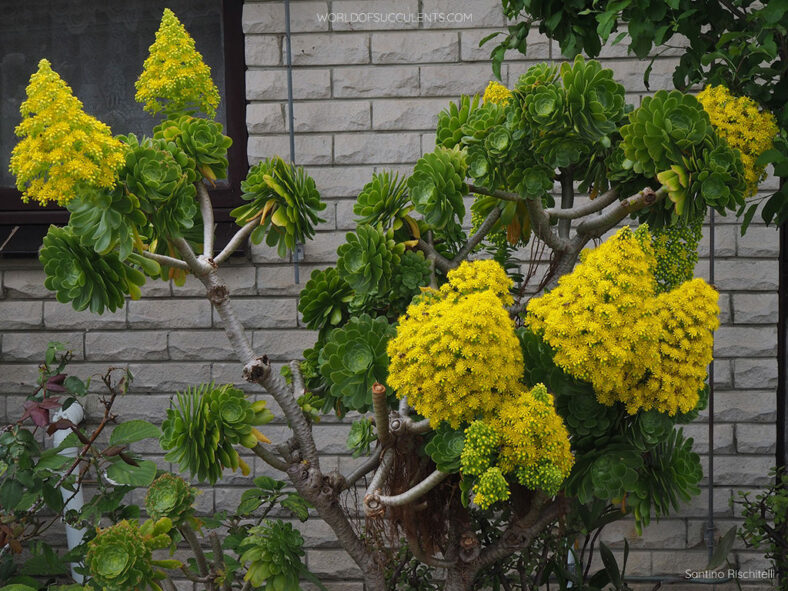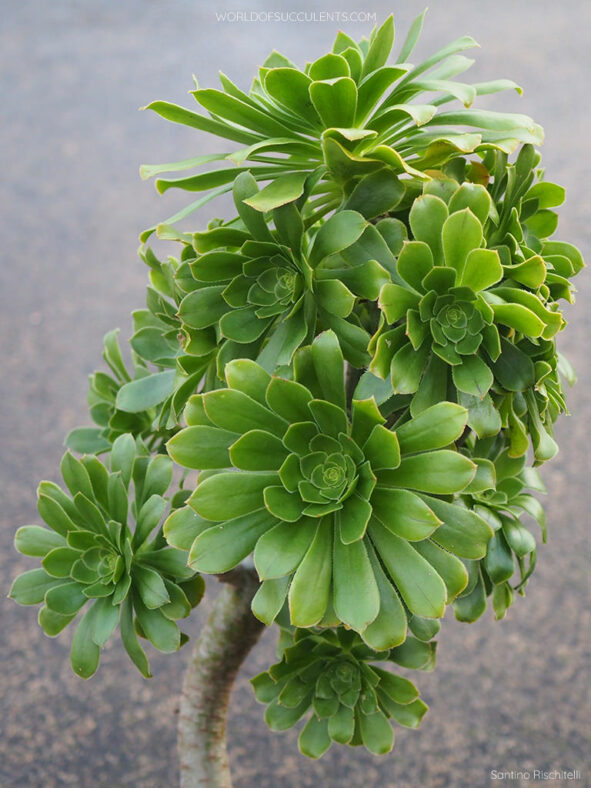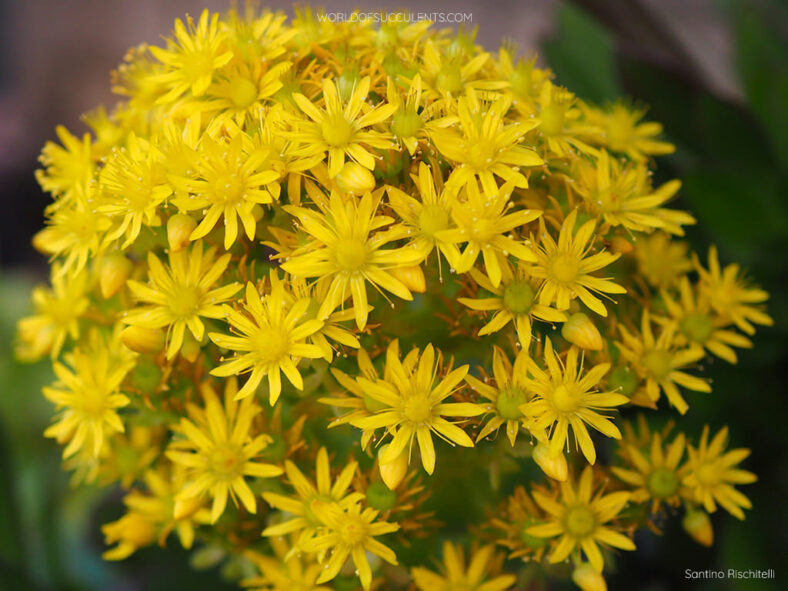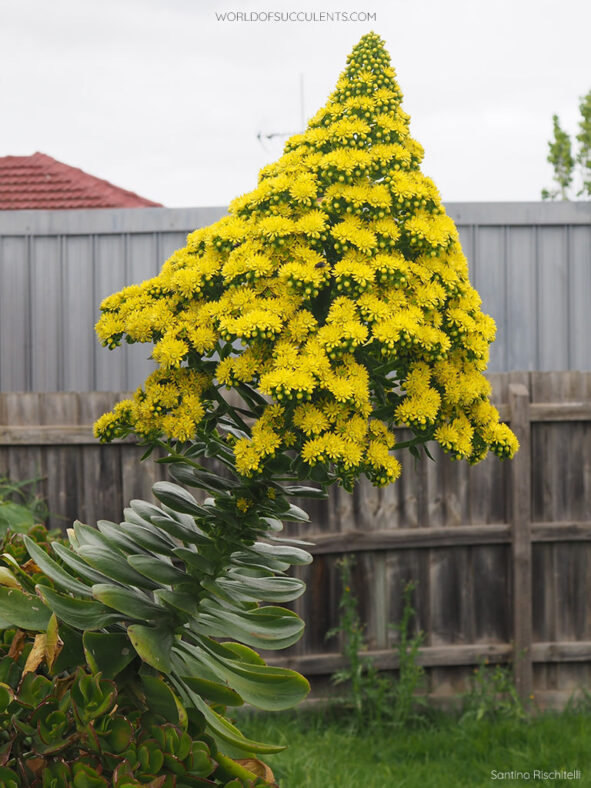Aeonium arboreum is a species with various cultivars that are quite common in cultivation.
Scientific Name
Aeonium arboreum (L.) Webb & Berthel
Common Name(s)
Houseleek Tree, Irish Rose, Tree Anemone, Tree Aeonium
Synonym(s)
Sempervivum arboreum
Scientific Classification
Family: Crassulaceae
Subfamily: Sempervivoideae
Tribe: Aeonieae
Genus: Aeonium
Etymology
The specific epithet "arboreum" (pronounced "ar-BOR-ee-um") means "tree-like" and refers to the growth habit of this species.
Origin
Aeonium arboreum is native to the Canary Islands. It is endemic to Gran Canaria and grows in sunny or slightly shaded places on weathered volcanic soil at elevations ranging from 650 to 3,950 feet (200 to 1200 m). The populations found on the Iberian Peninsula, the Mediterranean, and the Moroccan coast are likely to be considered neophytes.
Description
Aeonium arboreum is a few-branched succulent shrub with nearly smooth stems that bear dense terminal rosettes of fleshy, glossy green leaves with curved cilia along the margins. It can grow up to 6.6 feet (2 m) tall. The stems are erect or ascending, branched, and can reach up to 1.6 inches (4 cm) in diameter. The rosettes can grow up to 10 inches (25 cm) in diameter and have a flattened center with the young leaves tightly appressed to each other. During the summer dormancy, the rosettes are much smaller. The leaves are spoon-shaped, measuring up to 6 inches (15 cm) long and 1.8 inches (4.5 cm) wide.
Large conical to egg-shaped clusters of small, bright yellow, star-shaped flowers appear on stalks that can grow up to 8 inches (20 cm) long from late winter through early spring. The flower clusters can reach up to 10 inches (25 cm) in length and 6 inches (15 cm) in diameter. The flowers can measure up to 0.8 inches (2 cm) in diameter and have 9 to 11 spreading, narrowly oblong to lance-shaped petals. After flowering, the rosettes die.
Subspecies and varieties of Aeonium arboreum
- Aeonium arboreum subsp. arboreum
- Aeonium arboreum subsp. holochrysum
- Aeonium arboreum subsp. korneliuslemsii
- Aeonium arboreum var. rubrolineatum (now usually listed as a separate species Aeonium rubrolineatum)
Varieties, Forms, and Cultivars of Aeonium arboreum
- Aeonium arboreum 'Albovariegatum'
- Aeonium arboreum 'Atropurpureum'
- Aeonium arboreum 'Atropurpureum Cristatum'
- Aeonium arboreum 'Zwartkopf'

How to Grow and Care for Aeonium arboreum
Light: Aeonium arboreum thrives in full sun to partial shade, but in summer, light shade may be necessary, especially during the hotter afternoon hours. When growing indoors, ensure it receives as much bright indirect light as possible to prevent it from becoming leggy and stretched.
Soil: Unlike most succulents, this plant requires a sandy loam or regular potting soil amended with perlite. Avoid placing it in premade soil mixes designed for succulents since it needs more moisture than they typically provide.
Temperature: Aeonium arboreum does not like hot or dry weather, so it may go dormant in summer. It grows best in USDA Plant Hardiness Zones 9b to 11b, with average minimum winter temperatures ranging from 25°F to 50°F (-3.9°C to 10°C).
Watering: Water the plant thoroughly in spring and fall, allowing the soil to dry before watering again. Water it more sparingly during the winter. While this plant requires more water than most succulents, too much moisture can lead to root rot. Stop watering except in arid conditions during its summer dormancy.
Fertilizing: To promote healthy growth, apply a water-soluble fertilizer diluted to half the recommended strength. Feed only during the growing season.
Repotting: If growing Aeonium arboreum in a container, repot it every two to three years during the spring. Choose a container with drainage holes to prevent root rot.
Propagation: This plant is easy to propagate by taking cuttings in spring. Before placing it in the soil, allow the cut end to dry for several days. It is also easy to start from seeds. For best results, sow the seeds in spring.
Learn more at How to Grow and Care for Aeonium.
Toxicity of Aeonium arboreum
Aeonium arboreum is considered non-toxic, so it is safe for growing around children and pets.
Links
- Back to genus Aeonium
- Succupedia: Browse succulents by Scientific Name, Common Name, Genus, Family, USDA Hardiness Zone, Origin, or cacti by Genus
Photo Gallery
Click on a photo to see a larger version.


